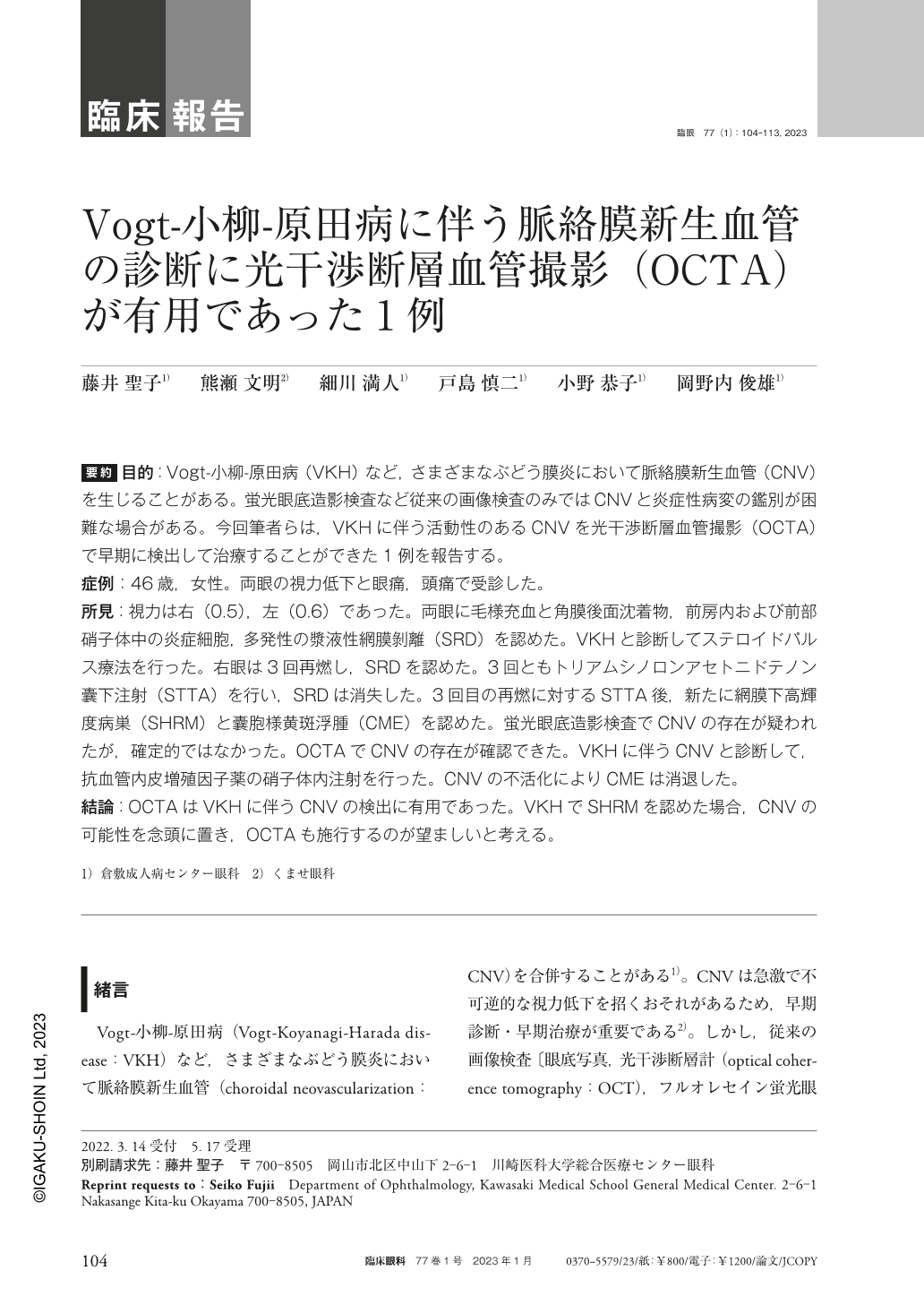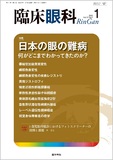Japanese
English
- 有料閲覧
- Abstract 文献概要
- 1ページ目 Look Inside
- 参考文献 Reference
要約 目的:Vogt-小柳-原田病(VKH)など,さまざまなぶどう膜炎において脈絡膜新生血管(CNV)を生じることがある。蛍光眼底造影検査など従来の画像検査のみではCNVと炎症性病変の鑑別が困難な場合がある。今回筆者らは,VKHに伴う活動性のあるCNVを光干渉断層血管撮影(OCTA)で早期に検出して治療することができた1例を報告する。
症例:46歳,女性。両眼の視力低下と眼痛,頭痛で受診した。
所見:視力は右(0.5),左(0.6)であった。両眼に毛様充血と角膜後面沈着物,前房内および前部硝子体中の炎症細胞,多発性の漿液性網膜剝離(SRD)を認めた。VKHと診断してステロイドパルス療法を行った。右眼は3回再燃し,SRDを認めた。3回ともトリアムシノロンアセトニドテノン囊下注射(STTA)を行い,SRDは消失した。3回目の再燃に対するSTTA後,新たに網膜下高輝度病巣(SHRM)と囊胞様黄斑浮腫(CME)を認めた。蛍光眼底造影検査でCNVの存在が疑われたが,確定的ではなかった。OCTAでCNVの存在が確認できた。VKHに伴うCNVと診断して,抗血管内皮増殖因子薬の硝子体内注射を行った。CNVの不活化によりCMEは消退した。
結論:OCTAはVKHに伴うCNVの検出に有用であった。VKHでSHRMを認めた場合,CNVの可能性を念頭に置き,OCTAも施行するのが望ましいと考える。
Abstract Purpose:Choroidal neovascularization(CNV)may occur in a variety of uveitides, including Vogt-Koyanagi-Harada disease(VKH). It is sometimes difficult to distinguish CNV from inflammatory lesions only by conventional multimodal imaging including dye-based angiographies. The authors present a case of an active CNV secondary to VKH that was detected immediately using optical coherence tomography angiography(OCTA)and treated successfully.
Case:A 46-year-old woman presented with decreased visual acuity and pain in both eyes and headache.
Findings and Clinical Course:The patient's best-corrected visual acuity was 0.5 in the right eye and 0.6 in the left. Ciliary hyperemia, keratic precipitates, inflammatory cells in the anterior chamber and the anterior vitreous, and multiple serous retinal detachment(SRD)were observed in both eyes. She was diagnosed with VKH and received steroid pulse therapy. The right eye had three recurrent attacks, in which SRD developed. SRD resolved after sub-Tenon triamcinolone acetonide(STTA)injection for each recurrent attack. After the third STTA injection, subretinal hyperreflective material(SHRM)and cystoid macular edema(CME)developed. Dye-based angiographies revealed the possible presence of CNV, but they were inconclusive. OCTA confirmed the presence of CNV. A diagnosis of CNV secondary to VKH was made, and she received an intravitreal anti-vascular endothelial growth factor injection. CNV then became inactive, and CME resolved.
Conclusion:OCTA can be a useful tool for detecting CNV secondary to VKH. When SHRM is found in a patient with VKH, OCTA should be performed with underlying CNV in mind.

Copyright © 2023, Igaku-Shoin Ltd. All rights reserved.


